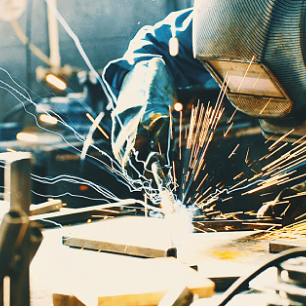Jump to:
Aluminum Welding Unlocked: Five Top Strategies for Root Fusion
When it comes to welding aluminum joints, root fusion is vital for strong, lasting welds. But it can be elusive. Root fusion in fillet welds is achieved when weld metal completely melts the base metal down to the joint root. Yet due to aluminum’s high rate of thermal conductivity, heat from the arc is transferred throughout the piece of metal rather than remaining concentrated toward the joint root, which deters root fusion. According to AWS D1.2/D1.2M:2014, Structural Welding Code — Aluminum, Section 3.6.3 (6), “The weld shall exhibit complete fusion in the root and to the base metal by the macroetch test.” Despite its challenges with aluminum, root fusion is necessary and attainable with the right techniques.
Incomplete fusion in welds can cause failure to occur. For groove welds, root fusion can easily be supported by using a 60-deg included angle. This opens up the weld much wider than the typical 45-deg angle used in steel. But checking for root fusion in both groove and fillet welds with the naked eye is challenging. For groove welds, x-ray and ultrasonic testing are options. With fillet welds, root fusion can be tested only by destroying the weld piece through performing a macroetch test for fusion depth and a fracture test for soundness. Working deliberately toward root fusion is more efficient than relying on postweld testing to make sure it occurs.
The shortest path to root fusion in aluminum welding is through techniques that enhance that possibility. Here are the five best practices for boosting the potential for adequate root fusion.
Remove Oxide
When preparing aluminum for welding, the first step is to clean the surface with solvent. Aluminum has a naturally occurring layer of oxide that forms the moment it’s exposed to the atmosphere. At around 4–5 nanometers, this layer self limits and won’t grow unless it’s exposed to moisture. But when aluminum oxide is contaminated with oils, grease, and moisture, hydrated aluminum oxide forms and grows. Moisture and oils on the surface of the aluminum can lead to porosity in the weld. Fed by the moisture, this layer of oxidation can grow infinitely. Removing moisture and cleaning with an acetone solvent can lead to better root fusion.
The next step is to remove the aluminum oxide with a stainless steel wire brush. When the oxide layer grows thicker, it’s harder to get fusion because it’s electrically resistant and has a much higher melting point. Aluminum oxide melts at 3762°F, three times the temperature to melt aluminum (1221°F). This is why the oxide layer should be removed before welding to ensure good fusion.
Increase Amperage and Stay in Front of the Pool
As with any metal, higher amperage leads to more heat pumped into the part. This keeps the pool hot and boosts the probability of root fusion in the thermally conductive aluminum. To gain more access to the joint root, it’s crucial to stay in front of the pool. Falling back on top of the pool creates a cushion that absorbs the energy from the arc and prevents that heat from reaching the joint root. A much faster travel speed is needed to ensure you stay in front of the pool. Another way to increase the chances of root fusion is to use straight stringer beads when welding. Sometimes when gas metal arc welding, operators will use the whip-and-pause technique to create a stack of dimes look, but that can also lead to incomplete fusion because the arc isn’t on the leading edge of the pool the entire time. Straight stringer beads are the best bet for root fusion when welding with aluminum.
Increase the Wire Diameter
Heat from many angles is needed to reach root fusion in aluminum. To that end, a larger wire diameter carries a larger current density capacity. Higher current density means more current is gained from a given wire feed speed than would be gained from a smaller diameter. With the larger diameter, less wire surface area is added, which decreases the naturally occurring oxide layer on aluminum wire. So, larger wire diameter also helps minimize porosity. For thicker materials, running a 0.062-in.-diameter or larger wire will help pump heat and amperage into the weldment. With today’s pulse capabilities, operators can run larger wire diameters on thinner materials. This can help simplify inventory while increasing the chance of consistent root fusion.
Switch to a Helium-Argon Gas Mix
Another way to achieve that all-important heat required for root fusion in aluminum welds is to switch to an argon-helium gas mix. Though helium is in short supply and has a premium price tag, it’s exponentially more effective at heating metal than argon alone. Helium’s higher ionization potential and greater rate of thermal conductivity make it ideal for welding aluminum. Argon conducts heat so poorly that it’s used between double- and triple-pane windows to prevent the transfer of heat and cold from the indoors to the outdoors and vice versa. Though argon is a stable gas for welding aluminum, it’s not the best for getting heat into the part for root fusion.
Preheat
Ninety percent of incomplete fusion happens at the beginning of the aluminum weld — the coldest point of the weld. The metal warms up within a few inches of welding, so heat from the arc stops moving away from the pool. AWS standards allow preheating to 250°F for aluminum. An optimal way to preheat is with a heat gun. Preheating with torches and fuel deposits water on the aluminum as a byproduct of burning fuel additive. This can lead to the dreaded hydrated aluminum oxide, which increases porosity and decreases the likelihood of root fusion. Many welders now include a hot start function that temporarily elevates the wire feed speed and voltage at the beginning of a weld, upping the odds for root fusion at that point in the weld.
Ending Thoughts
Achieving root fusion can be a challenge when welding aluminum. Incomplete fusion reduces throat thickness in fillet welds and can cause the weld to fail prematurely. Aluminum’s unique thermal conductivity and oxide layer that inhibit root fusion can be manipulated with five key practices: removing oxide, increasing amperage and staying in front of the pool, increasing wire diameter, switching to an argon-helium gas mix, and preheating. By following these best practices, root fusion can be achieved easily and regularly.
This article was written by Sean Walkowski (aluminum applications engineer at Hobart Filler Metals) for the American Welding Society.


